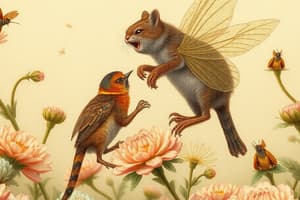Podcast
Questions and Answers
What are the three primary components of seed dispersal by animals?
What are the three primary components of seed dispersal by animals?
Seed production, seed transportation by animals, and seed deposition in suitable environments
What rewards do plants offer to animals in exchange for carrying away seeds?
What rewards do plants offer to animals in exchange for carrying away seeds?
Sugars, minerals, or proteins
What is the term for fruits that attach themselves to animals' bodies or fur for seed dispersal?
What is the term for fruits that attach themselves to animals' bodies or fur for seed dispersal?
Zoochory or epizoochory
Why is seed dispersal by wild animals critical for the long-term survival of many plant species?
Why is seed dispersal by wild animals critical for the long-term survival of many plant species?
Which types of animals play significant roles in moving seeds to new locations for seed dispersal?
Which types of animals play significant roles in moving seeds to new locations for seed dispersal?
How does seed dispersal by animals contribute to fostering biodiversity and conserving ecosystem health?
How does seed dispersal by animals contribute to fostering biodiversity and conserving ecosystem health?
What happens to seeds when an animal consumes a fruit?
What happens to seeds when an animal consumes a fruit?
What factors influence seedling survival after seed dispersal?
What factors influence seedling survival after seed dispersal?
How does habitat loss and fragmentation affect the role of animals as seed dispersers?
How does habitat loss and fragmentation affect the role of animals as seed dispersers?
What are some conservation implications of the decline of seed dispersers?
What are some conservation implications of the decline of seed dispersers?
What do researchers advocate for in order to address the issues related to seed dispersers?
What do researchers advocate for in order to address the issues related to seed dispersers?
Why is it important for humans to recognize and support the roles played by seed dispersers?
Why is it important for humans to recognize and support the roles played by seed dispersers?
Flashcards are hidden until you start studying
Study Notes
Animal Seed Dispersal: Unseen Heroes in Forest Regeneration
In the vast tapestry of nature, many elements work together to ensure the continued existence of life. Among them, seed dispersal by animals is a crucial yet often overlooked factor in fostering biodiversity and conserving ecosystem health. While pollinators tend to receive more attention, seed dispersers play an equally vital role in propagating plant species and maintaining habitat integrity.
The Role of Animals in Seed Dispersal
The process of seed dispersal involves three primary components: seed production (fruits containing seeds), seed transportation by animals, and seed deposition in suitable environments for germination. Each step contributes significantly to the overall vitality and resilience of plant communities:
-
Fruit Production: Many plants produce fruits that are attractive to animals, offering rewards like sugars, minerals, or proteins in exchange for carrying away seeds. Some fruits, known as zoochory or epizoochory, attach themselves to animals' bodies or fur, while others require more active participation from the animals, such as cracking open hard shells.
-
Transportation by Animals: Seed dispersal by wild animals is critical for the long-term survival of many plant species. Birds, mammals, reptiles, and insects play significant roles in moving seeds to new locations, ensuring genetic diversity and contributing to the process of natural selection. When an animal consumes a fruit, it ingests seeds, which pass through its digestive system before being deposited elsewhere, often in the form of feces. The seeds can be carried considerable distances, sometimes hundreds of kilometers, depending on the size of the animal and the structure of its habitat.
-
Deposition in Suitable Environments: Once the seeds are dispersed, they must find suitable conditions for germination and early growth. Seedling survival depends largely on the environmental conditions at the site of dispersal, including soil moisture, temperature, light availability, and the presence of competitors or predators. If the seeds fall too far away from the parent plant, they may struggle to establish due to unfavorable conditions or lack of resources to grow.
Conservation Implications
As human activities create pressures on wildlife populations and habitats, the role of animals as seed dispersers becomes increasingly jeopardized. Habitat loss, fragmentation, and the decline of native fauna threaten the ability of plants to maintain healthy populations and adapt to changing conditions. For example, the loss of seed dispersal by some animal species can lead to a decline in the population growth rate of plants, making them more susceptible to extinction.
To address these issues, researchers advocate for increased awareness of the importance of seed dispersers for biodiversity and ecosystem functioning. They encourage interdisciplinary collaboration to develop strategies for conserving these key actors in nature's web of relationships. This includes efforts to mitigate the impacts of habitat destruction, promote the recovery of declining species, and foster public education and engagement around the role of seed dispersers in sustaining our planet's health.
Conclusion
The intricate relationship between animals and plant species through seed dispersal is a testament to the delicate balance of life on earth. As humans continue to alter landscapes and disrupt natural processes, it is more important than ever to recognize and support the roles played by these unsung heroes in maintaining a vibrant ecosystem. By understanding the critical function of seed dispersal, we can better appreciate the complexity of nature and take steps to protect these valuable connections for generations to come.
Studying That Suits You
Use AI to generate personalized quizzes and flashcards to suit your learning preferences.




